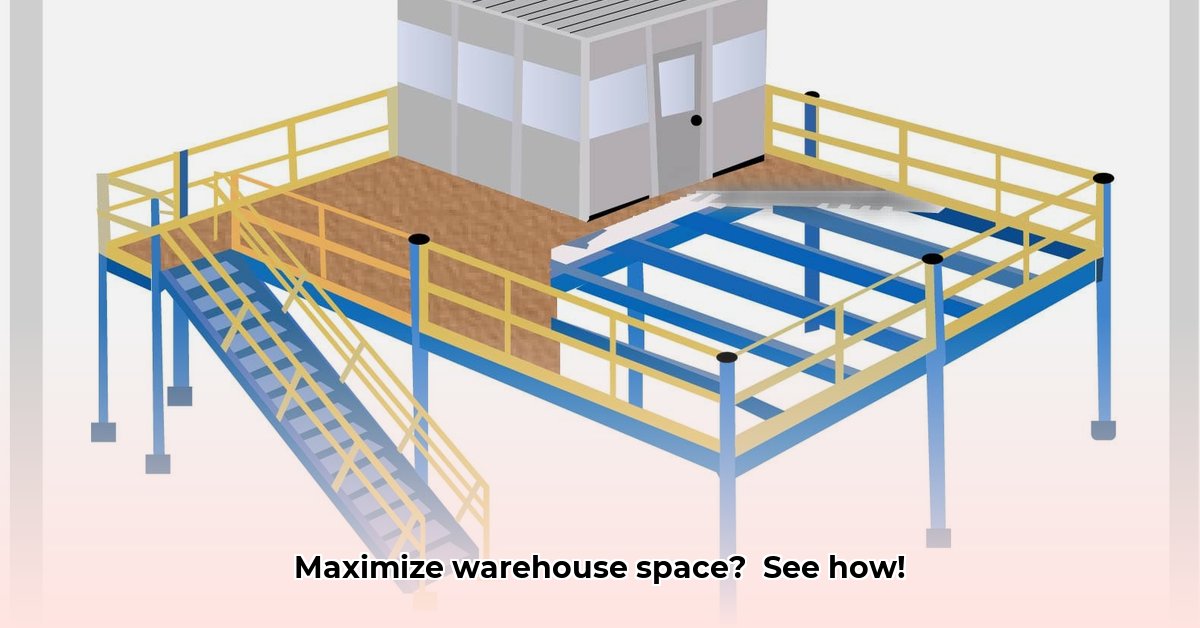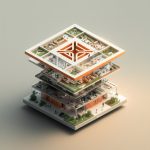Need more space in your warehouse without expanding the building’s footprint? Mezzanine floors offer a compelling solution, providing extra storage or workspace by utilizing vertical space. Navigating the array of available systems and manufacturers can be daunting, however. This guide provides a comparative analysis of leading manufacturers like Wildeck, Craftsman, Metsec, and Porta-King, equipping you with the knowledge to make an informed decision. We’ll explore essential factors such as load capacity, expandability, cost-effectiveness, safety compliance, and installation considerations. For detailed construction specifics, see this helpful guide on mezzanine floor construction. Let’s identify the perfect mezzanine solution for your business needs!
Mezzanine Solutions: Your Guide to Optimized Warehouse Space and Increased Efficiency
Maximizing your warehouse’s potential is crucial for efficient operations. A mezzanine floor, an intermediate level constructed within your existing structure, presents an effective solution for expanding usable space. However, choosing the right mezzanine system can be challenging. This guide will equip you with the knowledge to select the ideal mezzanine floor framing system to meet your specific needs. This is key to optimizing warehouse space and improving overall workflow in your warehouse.
Understanding Your Warehouse’s Needs: A Critical First Step
Before exploring different systems, it’s essential to thoroughly understand your warehouse’s current state and future goals. Consider these key factors to ensure the right system is chosen:
- Load Capacity Requirements: What types of goods will be stored on the mezzanine? The weight of these goods directly influences the required framing system. Heavier loads necessitate sturdier and potentially more expensive steel framing. Ensuring adequate load capacity is vital for safety and preventing structural issues. Consult with a structural engineer to determine precise load requirements.
- Space Requirements: Accurately measure your warehouse’s dimensions to determine the potential additional square footage a mezzanine can provide. This will help define the structure’s size and configuration. Consider both immediate and future expansion needs. Account for the placement of support columns and their impact on existing operations.
- Budgetary Constraints: Mezzanine systems vary significantly in price. Establishing a budget upfront helps narrow down the choices and prevents unexpected costs. Remember to factor in installation costs, permits, safety features (handrails, gates), and desired extra features.
- Scalability and Future Expansion: Do you anticipate future growth and increased space requirements? Modular systems offer the advantage of easy expansion, saving time and costs compared to a complete rebuild. Consider a system that allows for easy reconfiguration as your business evolves.
- Integration with Existing Equipment: How will your existing material handling equipment integrate with the mezzanine? Seamless integration with forklifts, conveyors, and vertical reciprocating conveyors (VRCs) can significantly streamline warehouse operations. Factor in the cost of integrating these systems.
- Accessibility Requirements: Ensure the mezzanine design complies with accessibility standards, including appropriate ramps or lifts for personnel with disabilities.
- Fire Safety Considerations: Determine the fire-resistance requirements for the mezzanine structure. Consider fire suppression systems and emergency exits to ensure compliance with fire safety codes.
Top Manufacturers: A Head-to-Head Look at Mezzanine Solutions
Several companies are leading the way in providing mezzanine solutions. Let’s examine their strengths and weaknesses to aid in your decision-making process:
| Manufacturer | What They Do Best | What to Consider | Best Suited For |
|---|---|---|---|
| Wildeck | Excellent integration with material handling systems (like conveyors), often designs and builds in-house, VRC integration. | Could be pricier upfront; remember to consider long-term ROI as opposed to initial investment. | Warehouses needing smooth material flow, custom solutions, and seamless VRC integration. |
| Metsec | Optimizing headroom with inset floor beam systems, offering both oversail and inset designs for diverse needs | Restrictions on finished floor height may dictate system choice | Warehouses that prioritize efficient use of vertical space, offices, retail environments |
| Craftsman | Known for modular designs, easy expansion, rack-supported systems, suitable for lighter loads, cost-effective. | Usually better suited for lighter loads, requiring thorough load capacity planning, limited customization. | Smaller businesses or companies anticipating growth with lighter merchandise, requiring flexible configurations. |
| Porta-King | Specializes in durable structures using high-quality American materials, customizable decking options, robust connection types. | Might not be the perfect fit for projects requiring rapid assembly or extremely lightweight designs. | Businesses prioritizing durability, custom decking solutions, and robust connections for heavier loads. |
Key Design Choices: The Nitty Gritty Details of Warehouse Efficiency
Delving deeper into crucial design decisions is essential for a successful mezzanine project that improves warehouse efficiency.
- Material Selection: Steel is a leading choice for its superior strength and durability, particularly for heavier loads and industrial environments. Wood can be a more budget-friendly alternative for lighter applications, but may not be suitable for all warehouse environments. Concrete decking, while heavy, offers excellent sound dampening and load capacity. Each manufacturer offers different material choices; carefully consider what best suits your warehouse environment and operational needs.
- Flooring Options: Consider various flooring options based on your specific needs, including:
- Concrete: Durable and high load-bearing capacity, suitable for heavy equipment.
- Steel Decking: Economical and versatile, available in various gauges and finishes.
- Bar Grating: Allows for air circulation and sprinkler penetration.
- Wood: Cost-effective for lighter loads, but may require additional reinforcement.
- Support Column Placement: Optimize the placement of support columns to minimize obstruction and maximize usable space on both the ground floor and the mezzanine level. Column spacing should align with existing racking systems and traffic patterns.
- Modular Design: Systems with a modular design (like those from Craftsman) allow for simple expansion as your business grows. This adaptability can save you significant time and money in the long run.
- Material Handling Integration: Seamless integration of material handling systems like vertical reciprocating conveyors (VRCs), conveyors, and lifts can significantly boost warehouse efficiency. Wildeck excels in this area, often providing integrated solutions.
- Safety Features: Incorporate essential safety features, including:
- Handrails and Guardrails: Provide fall protection along the perimeter of the mezzanine.
- Safety Gates: Ensure controlled access to the mezzanine, particularly in loading areas.
- Stairways: Design stairways that meet building code requirements for width, rise, and run.
- Lighting and Ventilation: Plan for adequate lighting and ventilation on the mezzanine level to create a comfortable and safe working environment. Consider natural light sources and energy-efficient lighting systems.
- Fire Suppression: Integrate fire suppression systems, such as sprinklers, to protect the mezzanine and its contents in the event of a fire. Ensure the system complies with fire safety codes.
- Safety First & Compliance: Adhering to building codes (like IBC, CBC, and OSHA standards) is essential. Reputable manufacturers comply with these regulations; always double-check to ensure compliance.
- Cost and ROI: A well-designed mezzanine system typically delivers a strong return on investment through increased storage space and improved operational efficiency. Don’t overlook potential tax benefits!
Minimizing Risks: A Proactive Approach to Industrial Mezzanine Design
Careful planning is essential for minimizing risks associated with industrial mezzanine design. Here are some common risks and mitigation strategies:
| Potential Risk | How to Avoid It |
|---|---|
| Faulty Materials | Verify the manufacturer’s certifications and material specifications. |
| Poor Installation | Choose a manufacturer with a proven record of quality installations. |
| Insufficient Load Capacity | Ensure accurate and conservative load calculations, with a safety factor. |
| Non-Compliance Issues | Verify that all plans meet local building codes and regulations. |
| Inadequate Fire Safety | Install appropriate fire suppression systems and emergency exits. |
| Insufficient Lighting | Provide adequate lighting to meet safety and operational requirements. |
| Poor Ventilation | Ensure adequate ventilation to maintain air quality and temperature. |
Installation Considerations: A Smooth and Efficient Process
- Professional Installation: Hire experienced and certified installers to ensure proper assembly and adherence to safety standards.
- Site Preparation: Prepare the installation site by clearing obstructions, leveling the floor, and ensuring adequate access for equipment and materials.
- Phased Installation: Consider a phased installation approach to minimize disruption to ongoing warehouse operations.
- Coordination with Other Trades: Coordinate the installation with other trades, such as electrical and mechanical contractors, to ensure seamless integration of all systems.
Making Your Decision: The Final Steps in Your Warehouse Space
Choosing the right mezzanine floor framing system depends on your specific needs. Consider each manufacturer’s strengths, budget, scalability needs, and equipment integration requirements. Obtain quotes and detailed specifications from multiple vendors. Visit completed installations to assess the quality of workmanship. Take your time; this is a significant investment! Don’t hesitate to ask questions and compare. The perfect mezzanine is out there; careful consideration is key.
How to Compare Industrial Mezzanine System Quotes for Optimal ROI
Key Takeaways for Investment Protection:
- Mezzanine floors significantly increase usable space, boosting warehouse efficiency and
- Glass Mosaic Backsplash: A Stylish Upgrade For Your Kitchen - December 8, 2025
- Glass Tile Shower Ideas to Create a Stunning Bathroom Space - December 7, 2025
- Glass Wall Tile Ideas for Kitchens and Bathrooms - December 6, 2025










